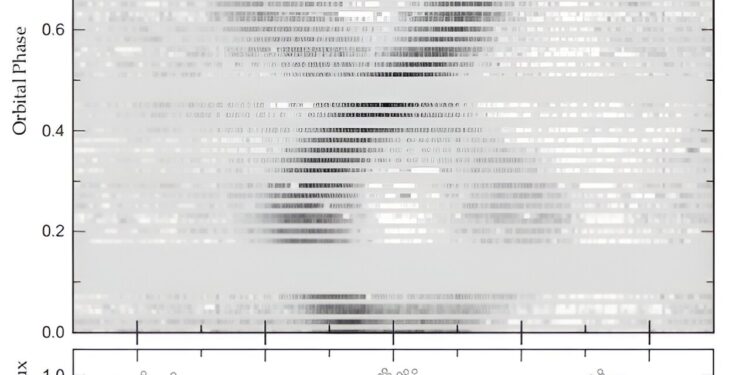The upper panel displays the trailed spectra of XZ UMa in the Fe I λ4957 region. In the lower panel, the circle represents the spectrum observed at an orbital phase of 0.256 (BJD 2 459 554.2000), the blue, green and red lines represent the synthetic spectra of the primary components and their convolution spectrum, respectively. Credit: arXiv (2023). DOI: 10.48550/arxiv.2312.13642
Astronomers have conducted a photometric and spectroscopic study of an Algol-type binary, known as XZ Ursae Majoris (or XZ UMa for short). Study results, presented in a paper published Dec. 21 on the preprint server arXivindicate that this binary is a pulsed system.
Algol-type binaries are a class of eclipsing binary stars related to the prototype member of this class, known as Beta Persei or Algol. These are semi-detached systems in which the less massive component transfers mass to the more massive component due to the filling of its Roche lobe, causing a loss of mass and angular momentum.
XZ UMa is a semi-detached Algol type system with spectral type A5+F9. It has an orbital period of about 1.22 days and the main component of the system is estimated to have an effective temperature of about 7,766 K.
Previous observations have suggested that XZ UMa exhibits pulsations; however, no evidence confirming this hypothesis has been found. Some studies also found that the orbital period of XZ UMa had changed over the years, suggesting the presence of a third object in the system about half as massive as the sun.
To verify these theories, a team of astronomers led by Jae Woo Lee of the Korea Institute of Astronomy and Space Science in Daejeon, South Korea, carried out high-resolution spectroscopic observations of XZ UMa with the Spectrograph Bohyunsan Observatory scale and the 1.8-m spectrograph at the Bohyunsan Optical Astronomy Observatory (BOAO). The study was supplemented by photometric data from NASA’s Transiting Exoplanet Survey Satellite (TESS).
Lee’s team managed to identify at least six possible independent pulsation frequencies of XZ UMa. Their periods and constants of these pulsations were measured between 28 and 37 minutes and 0.013 to 0.016 days, respectively. The pulsation-orbit period ratios for high frequencies were found to be 0.016 to 0.021, suggesting that the primary star XZ UMa A is a Delta Scuti-type pulsator.
The study found that XZ UMa A has a rotational speed of around 80 km/s, suggesting that it is likely currently in a super-synchronous state. The effective temperature of XZ UMa A was measured at 7,940 K, while its metallicity was found to be at a level of -0.15. The primary star was found to be about 76% larger and slightly more than twice as massive as the sun.
As for the secondary star, the results indicate that it has a radius of about 2.48 solar radii but its mass is only 1.35 solar masses. The effective temperature of XZ UMa B is estimated at 5,162 K.
Summarizing the results, the paper’s authors concluded that the XZ-type eclipsing binary UMa Delta Scuti is in a semi-detached configuration.
More information:
Jae Woo Lee et al, Absolute properties of the oscillating eclipsing Algol XZ Ursae Majoris, arXiv (2023). DOI: 10.48550/arxiv.2312.13642
Journal information:
arXiv
© 2024 Science X Network
Quote: Pulsations detected from the XZ Ursae Majoris system (January 4, 2024) retrieved on January 4, 2024 from
This document is subject to copyright. Apart from fair use for private study or research purposes, no part may be reproduced without written permission. The content is provided for information only.



